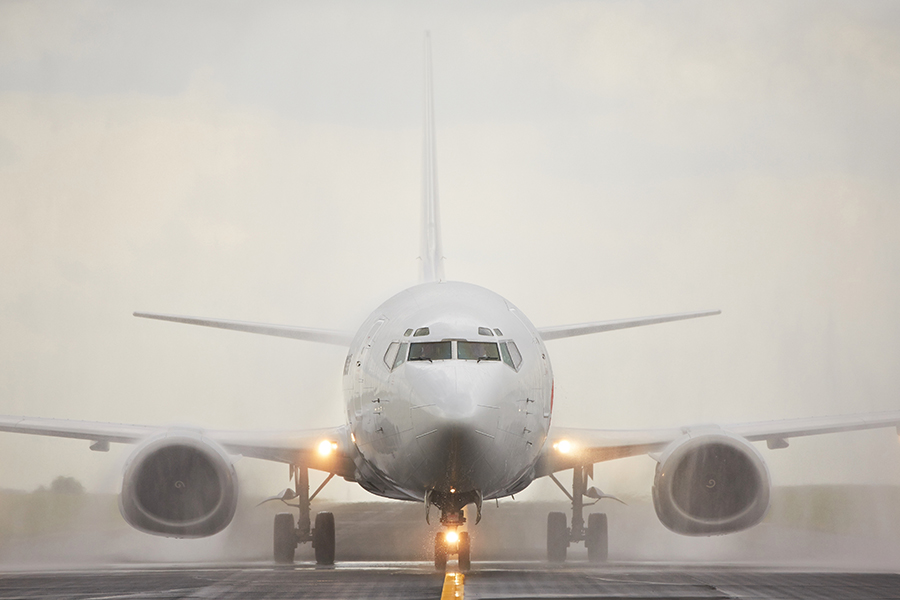-
Key Takeaways
-
What Is a Belly Landing?
- Belly Landing vs. Other Emergency Landings
- Understanding Belly Landings
-
The Main 3 Causes of Belly Landings
- 1. Pilot Error
- 2. Mechanical Malfunction
- 3. Environmental Factors
-
Risks Associated with Belly Landings
- Aircraft Damage
- Injury to Occupants
- Operational Hazards
-
Preventing Belly Landings
- Use Your Checklist
- Train Often
- Technological Aids
-
Emergency Procedures for Gear Malfunctions
- Troubleshooting
- Airplane News Update
- Flight Deck Actions
- Decision-Making
-
Performing a Safe Belly Landing
- Secure & Brief
- Configure Aircraft
- Pick a Surface
- Approach & Touchdown
- After Landing
-
Belly Landing Recovery and Aftermath
- Aircraft Assessment
- Regulatory Reporting
- Pilot Health and Recovery
-
Case Studies of Belly Landings
- Case Study 1: Pilot Error Leading to Belly Landing
- Case Study 2: Mechanical Failure Resulting in Gear-Up Landing
-
Conclusion
You’re on your final approach and suddenly realize your landing gear isn’t down. What now?
Belly landings, while rare, can happen to any pilot. This could be the result of pilot error or mechanical failure, but knowing how to handle landing gear failure can mean everything.
In this article, you’ll learn what causes belly landings, the risks they pose, and how to respond and prevent them through training, checklists, and system awareness.
Key Takeaways
- A belly landing happens when an aircraft lands without its landing gear extended.
- Most belly landings are preventable through proper checklist use and pilot awareness.
- Mechanical failures and environmental conditions can also cause gear-up landings.
- Training, system knowledge, and calm decision-making are key to a safe outcome.
What Is a Belly Landing?

A belly landing is an emergency gear-up landing that occurs with aircraft that have retractable landing gear. When the landing gear fails to extend, it forces the pilot to land the aircraft on its underside.
But how does this happen?
During certain phases of flight, you may retract the landing gear to reduce drag and improve climb performance. Later, as you approach your destination, you’ll need to extend the gear again for landing.
Landing gear systems are typically controlled hydraulically, electrically, or through a combination of both. But no system is completely foolproof. If there is landing gear failure or you simply forget to extend it, you may be forced to make an emergency gear-up landing.
This means touching down without some or all of the landing gear extended. Instead of rolling on wheels, the aircraft’s underside makes direct contact with the runway.
That’s why it’s called a belly landing.
While it may sound alarming, you, as a pilot, can be trained to handle this situation.
Belly Landing vs. Other Emergency Landings
What makes a belly landing different from other emergency landings? Essentially, it’s not a matter of where or when, but of how.
For example, a forced landing happens when you have no choice but to land, possibly because of an engine failure or other mechanical issue. This can happen anywhere. Depending on your options, you may be forced to land on a runway, a field, or even water.
If the weather becomes risky, if you’re having trouble with your fuel supply, or for any other reason, you might decide to land to avoid an emergency. This is called a precautionary landing.
Unlike a belly landing, you could perform these emergency landings with the gears extended and under more predictable conditions.
Understanding Belly Landings
While nobody ever wants to experience a belly landing, knowing how to handle one can make the difference between a minor incident and a disaster.
Although it sounds scary and destructive, it doesn’t have to be. You can reduce the damage to your aircraft and walk away with no casualties when you do it properly.
Your goal is to keep the aircraft level and touch down as smoothly as possible. The impact and subsequent friction can lead to injuries and damage to your aircraft if you don’t manage it well.
But despite these dangers, knowing and following the correct procedures can keep everyone safe.
The Main 3 Causes of Belly Landings
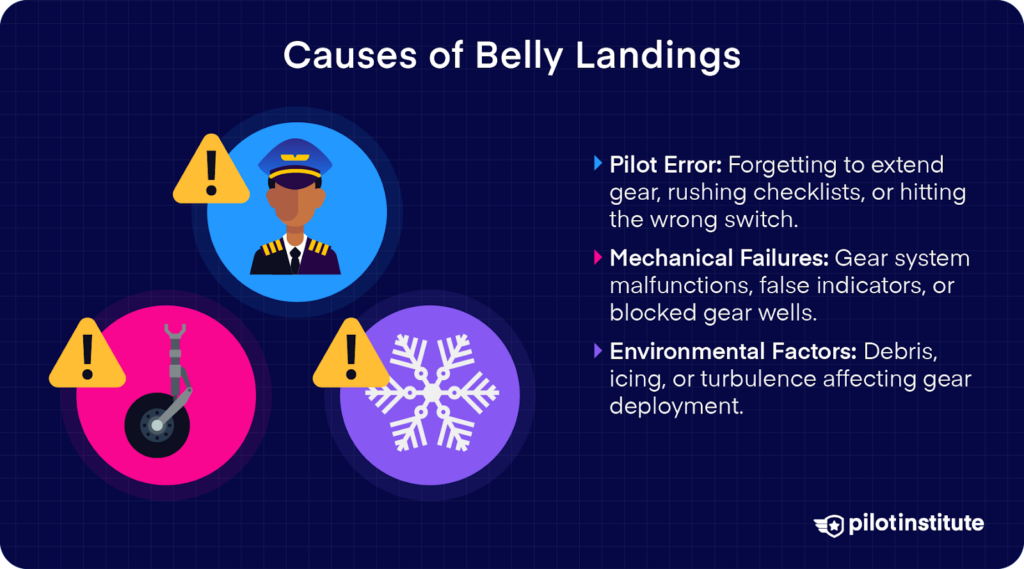
Before diving into what causes belly landings, it’s important to recognize that they can happen to any pilot, regardless of where the issue came from.
But with the right understanding, you can anticipate risks and take proactive steps to prevent a gear-up landing.
1. Pilot Error
One of the most common causes of belly landings is human error. Even experienced pilots make mistakes, especially in high-pressure situations. Which ones should you watch out for?
Neglecting to Extend Landing Gear
Distractions and workload pile up fast in the cockpit. The approach phase is an especially busy time, with multiple tasks happening at once.
You’re communicating with air traffic control and configuring for landing. A gust of unexpected turbulence might even throw you off. Amid all this commotion, you might end up forgetting to lower the landing gear.
Improper Checklist Use
That’s why you have pre-landing checklists. They’re your weapon against disaster! And they’ll serve their purpose if you use them well.
What does this mean? Don’t skip or rush through your checklist. You might miss important steps. You might even fully believe that you’ve already extended the landing gears when you haven’t. Once you realize your mistake, it could be too late.
No one is immune to time pressure, but impulsivity is an attitude you can manage. Think first before making any decisions.
Inadvertently Retracting Landing Gear on the Ground
Some belly landings have happened while the aircraft was already on the ground. Sounds impossible, but it happens.
Landing gear switches are usually placed near flap controls. You might mix up these switches during the landing roll or taxi, and instead of retracting the flaps, you retract the landing gears instead!
Complacency Over Time
Experience is valuable, but it can also lead to overconfidence. You may have performed hundreds of successful landings in the past. Because of this, you might assume your next landing will be just like the others.
This complacency will almost certainly put you in a tough spot when unrecognized. Routine breeds oversight, which is why you should always rely on procedures more than habit.
2. Mechanical Malfunction
But despite your best efforts, a belly landing could sometimes happen due to issues beyond you. There might be malfunctions in your aircraft that could lead to a belly landing.
Landing Gear System Malfunctions
Aircraft rely on hydraulic or electrical systems to extend and retract the landing gear. If any component in these systems fails, you could be left with no choice but to execute a belly landing.
Faulty Indicators and Warning Systems
Landing gear indicator lights are supposed to confirm whether the gear is down and locked. Different airplane models use different landing gear position indicators.
But whatever system you have on your aircraft, they’re still susceptible to errors. A malfunction can provide false readings, which might make you believe that the gear is extended when it isn’t.
Obstructions in Gear Wells
Foreign objects can sometimes block the landing gear from deploying. Debris, ice, or even bird nests can interfere with gear movement or cause false indications. Always check the landing gear and individual system components during preflight.
3. Environmental Factors
There are also elements outside that can contribute to a belly landing. Look out for these factors!
Foreign Object Damage (FOD)
Runway debris can damage landing gear mechanisms during takeoff or landing. If debris gets lodged in the gear system, it might not extend properly when needed, or even damage the whole system altogether.
Severe Weather Conditions
Turbulence, icing, or extreme cold can all affect gear operations. When ice builds up, the landing gear might not be able to lock into place.
Strong turbulence will make it difficult to confirm whether the gear has fully extended. In some cases, you may need to cycle the gear multiple times to overcome icing.
Risks Associated with Belly Landings
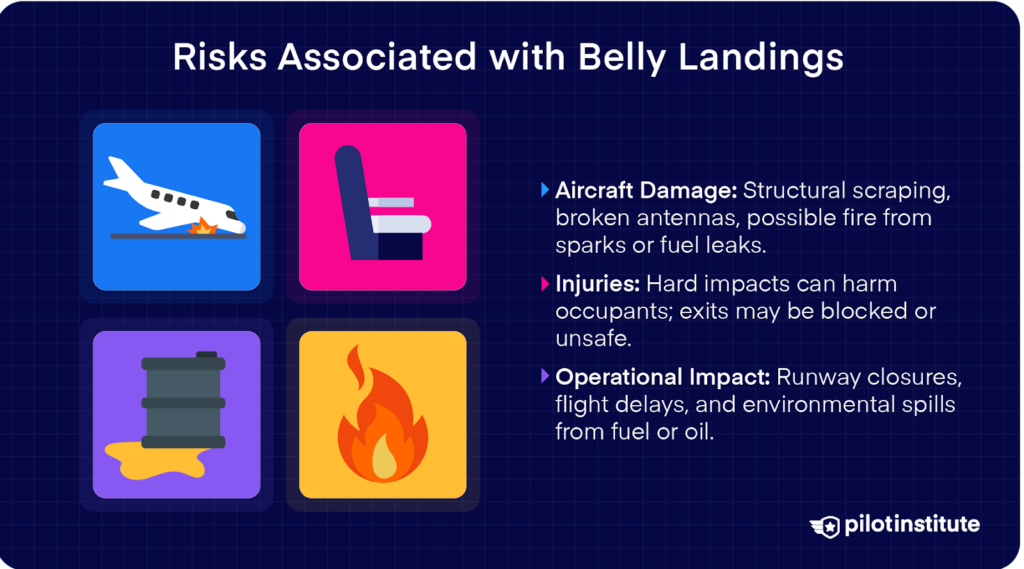
While some emergencies will call for a belly landing, they also come with a range of significant risks. You need to be aware of these risks so you won’t get caught off-guard.
Aircraft Damage
Structural Damage
When an aircraft makes a belly landing, the fuselage, wings, and propellers are at risk of severe damage. Your aircraft’s structural integrity could be compromised as it strikes and scrapes along the rough runway surface.
And even this is the best-case scenario. You may not have the advantage of landing on a runway at all. Instead, you might find yourself having to land on a rough, unimproved strip of grass. This will almost certainly cause more damage than a runway surface.
As you can imagine, fixing damage this serious will be quite expensive. In the worst cases, your aircraft might even be permanently grounded.
Fire Hazards
Although a belly landing on a runway is ideal, one of its biggest dangers is the risk of ignition.
How does this happen? Metal rubbing against the runway can create sparks. Friction alone can generate enough heat to ignite flammable materials. Add potential fuel leaks to the picture, and you’ve got the perfect formula for a fire.
Loss of Avionics and Systems
A lot of your aircraft’s antennas and sensors are located on the underside of the fuselage. These systems are vital, especially during and after landing.
In a belly landing, these components can get crushed or sheared off. Now you’ve got another problem on your hands: a loss of communications and navigation aids.
Without these components, navigation and coordination with air traffic control might become a struggle.
Injury to Occupants
Impact Injuries
Without landing gears to absorb shock, the impact forces of a belly landing will be much, much greater. This impact, plus the sudden deceleration, can lead to injuries to passengers and crew.
Even with seatbelts, the abrupt stop can cause whiplash, bruising, or more serious trauma.
Emergency Evacuation Risks
Belly landings can make evacuations more difficult. The doors to your aircraft can get damaged along with other components. Instead of being your exit, they might become a barrier to your way out.
Your aircraft might stop at an irregular orientation, leading to the cabin exit height becoming higher than usual. A fire could also break out along the exit path and cause some serious burns.
Operational Hazards
Runway Closures and Disruptions
A belly landing doesn’t just cause chaos to the aircraft and its occupants, but to almost everything in its wake. An event like this causes a ripple effect to its surroundings.
Aircraft operations will be severely disrupted. Runways might have to be closed for inspection and debris removal, so flights might be delayed or diverted. This will have an impact even on other flights and passengers.
Environmental Impact from Spills
Lastly, fuel, oil, and hydraulic fluid leaks are common after a belly landing. These substances pose environmental hazards. They’ll need to be contained and cleaned up immediately to prevent contaminating the soil and any nearby bodies of water.
Preventing Belly Landings
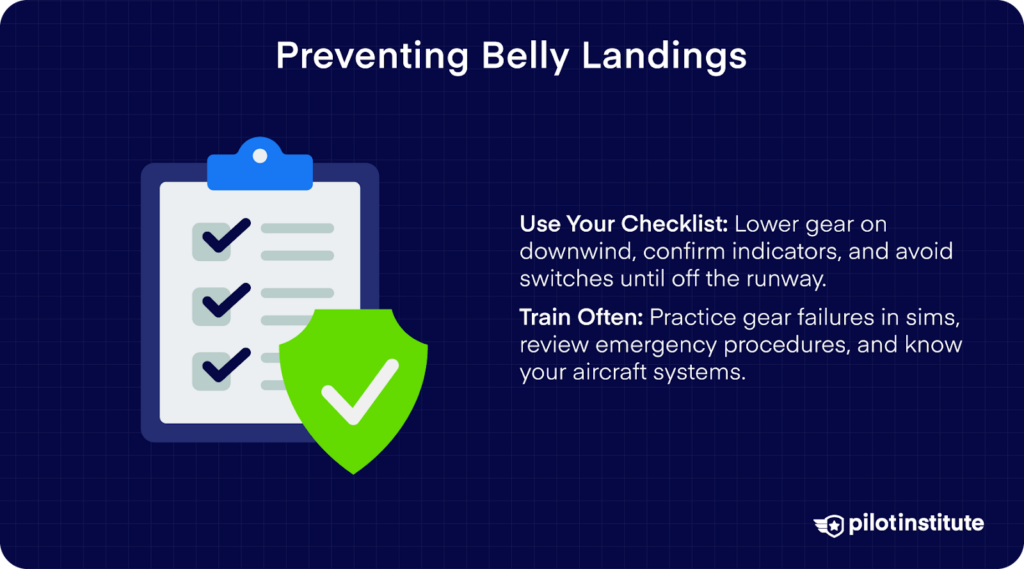
So, how can you keep yourself safe in a belly landing? Your greatest defense is to prevent it from happening in the first place.
Use Your Checklist
Don’t rely on memory. Follow your aircraft’s checklist every time.
Lower the gear on the downwind leg when abeam your landing point. This will help you confirm the gear is down and gives you a consistent place to check indicators.
Always verify gear extension with annunciator lights, mirrors, or visual cues.
Once you land, don’t touch switches until you’re off the runway. Doing this helps prevent accidental retraction on the ground.
Train Often
Practice makes safe. Regularly train for both normal and emergency gear ops. If you’re transitioning to a complex aircraft, work with a certified instructor and follow a structured syllabus.
Use simulators to run gear failure scenarios and sharpen your response time.
Keep alert, review your systems, study the manual, and keep procedures fresh in your mind.
Technological Aids
Gear Warning Systems
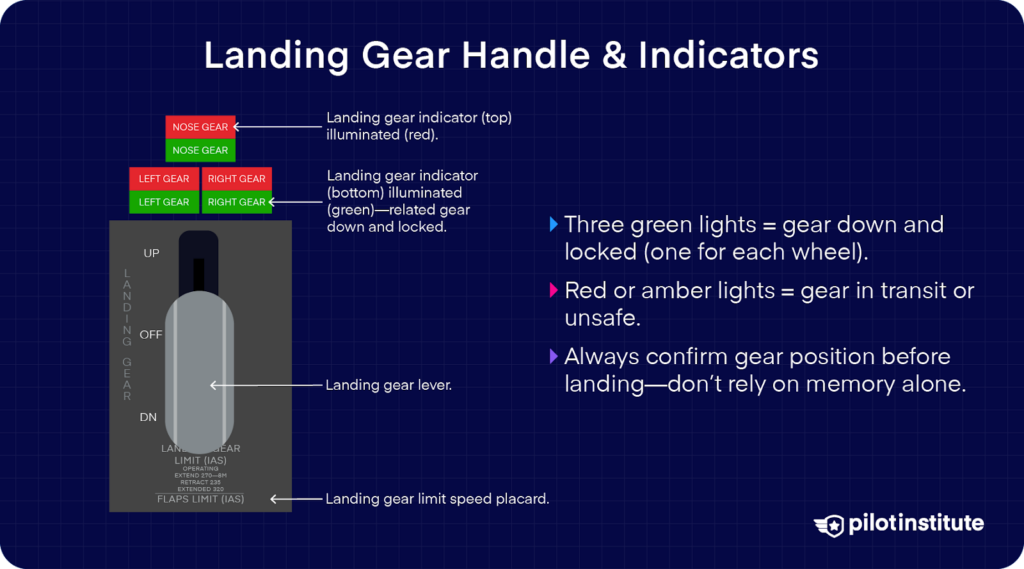
For example, some make use of light indicators. One type has a green light for gear down and an amber light for gear up.
Another type has three green lights, one for each wheel, to show when they’re locked in place. Some systems also use red or amber lights to warn when the gear is moving or unsafe for landing.
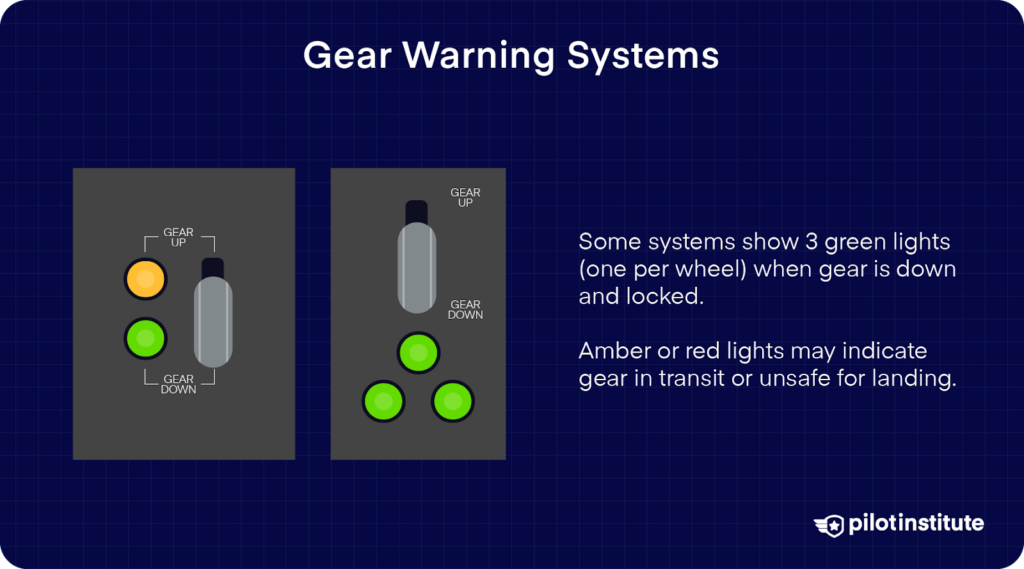
Tab-type indicators can also be found on some aircraft. These may show “UP” when the gear is locked up, red and white stripes when it’s unlocked, or a gear silhouette when it’s locked down.
In other aircraft, you may have electronic displays to show gear position without separate indicator lights.
Most airplanes have a warning horn that goes off when you’re already configured for landing but the gear still isn’t down and locked. This will be your warning and reminder to extend your landing gears when you’re about to land.
Reminding Yourself
Many pilots also call out, “Gear down, three green,” every time they land to prevent mistakes. This is a reference to the electrical indicator lights or painted panels of indicator units from the two main gears and the nosewheel (or tailwheel).
It’s also a good idea to place your checklists where they are easily visible. You can mount them on the instrument panel or your kneeboard for easy access.
Maintenance of Systems
If your aircraft has these systems, don’t forget to test them during preflight. Make sure they’re clear, and make function checks as a part of your preflight inspections.
Remember that dirt, moisture, and debris can interfere with gear mechanisms. Contaminants on switches and sensors could cause false readings or disrupt the extension cycle. When this happens, they might appear as if the gear is locked when it really isn’t.
Preflight and scheduled inspections help catch issues before they turn into failures. Always check for signs of any wear, corrosion, or leaks in hydraulic components. Make sure the moving parts are lubricated as recommended by the aircraft’s manual.
Routine cleaning and servicing keep these components reliable, which helps prevent gear malfunctions and a belly landing.
Emergency Procedures for Gear Malfunctions
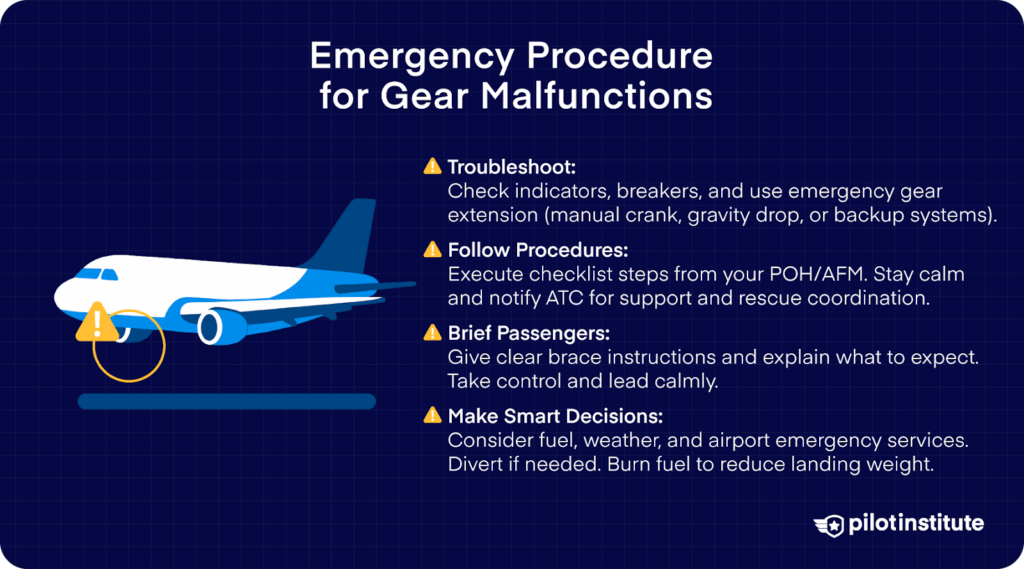
But let’s say, for whatever reason, the unthinkable happens: You have to make a belly landing. You’ve done every preventive measure but still end up with no other choice. What do you do next?
Troubleshooting
Verifying Gear Position Indicators
First, you need to verify whether there’s actually a problem. Stay calm, maintain control of your aircraft, and assess the situation. Are your landing gears truly malfunctioning? Confirm with the indicators in your cockpit.
If there’s still any uncertainty, look at the inspection windows. You can even ask the air traffic controller for a flyby. They’ll give you visual confirmation of the status of your landing gears.
Checking Circuit Breakers and Fuses
Next, inspect circuit breakers and fuses. You might be able to restore power to the gear system after resetting a tripped breaker.
Using Emergency Extension Systems
Is the issue coming from an electrical failure? If it is, you might be able to use an emergency extension system. Depending on your aircraft, this may involve manual cranks, hand pumps, or gravity drops.
In some airplanes, there’s an emergency release handle in the flight deck, which is connected through a mechanical linkage to the gear uplocks. When you pull the handle, it will release these uplocks, which will let the gears free-fall or extend under their own weight.
However, gravity and air loads might still not be enough to lower the gear, so additional systems were made to push it down. These systems make use of hydraulic fluid, compressed gas, or a manual hand crank.
Some aircraft also have backup hydraulic pumps, like an auxiliary hand pump or an accumulator, to give an extra push.
The ways these systems work vary from one aircraft to another. Do you know how yours works? So you won’t end up fumbling through your manuals while you’re in the deep end, be familiar with your aircraft’s emergency gear extension procedures as early as now.
Flight Deck Actions
Let’s hope these safeguards work and that you can land your aircraft without any trouble. But in the event that they fail and a belly landing is truly inevitable, what should you do next?
Your next actions will be extremely pivotal. Start by immediately performing the emergency procedures in your aircraft’s AFM or POH.
Follow every step precisely and down to the last detail. The manufacturer designed these checklists for your specific aircraft. Do not skip any steps, even if you’re under a lot of pressure. Take control of your aircraft and perform the procedures.
Next, alert air traffic control as early as possible. Once they know about your emergency, they’ll prioritize your landing and coordinate emergency services.
If you have the option, the ideal landing airport is one with crash and rescue capabilities. You can even request for emergency crews to be on standby.
Once you’ve got that settled, take care of your crew and passengers. It’s a distressing situation, and some of them might be in a panic. How can you get your passengers to cooperate?
Calmly and clearly brief everyone on what’s happening and what to expect. Give instructions on brace positions. Tell them about the emergency exits and what they should do once the aircraft stops. They’re relying on you for direction, so take authority.
Decision-Making
Another thing you can do to “soften the landing” is damage control. When facing a landing gear malfunction, good decision-making becomes just as important as technical skill.
Take a look at your options. Do you have enough time and fuel to spare to hold off a belly landing? Or is it best to prepare for the inevitable? Some important factors to consider are:
- Time
- Fuel
- Weather Conditions
- Airport Facilities
If time and fuel are on your side, then go ahead and troubleshoot. But if they’re running low, these resources will be better spent preparing for landing.
Check the weather conditions. Strong winds, low visibility, or icing can affect your options. Also, consider airport facilities. If you’re at a small field with limited emergency response, it might be best to divert to somewhere more favorable for a belly landing.
An alternate airport with better emergency services or longer runways will improve your odds of a safe landing. Don’t hesitate to change course if it means getting help where and when you need it.
You should also lessen your aircraft’s weight. Consider flying in a holding pattern to burn off excess fuel. This lowers landing speed, lessens the force of impact, and reduces the risk of a fire.
Just stay aware of your remaining fuel, and don’t wait too long to commit.
Performing a Safe Belly Landing
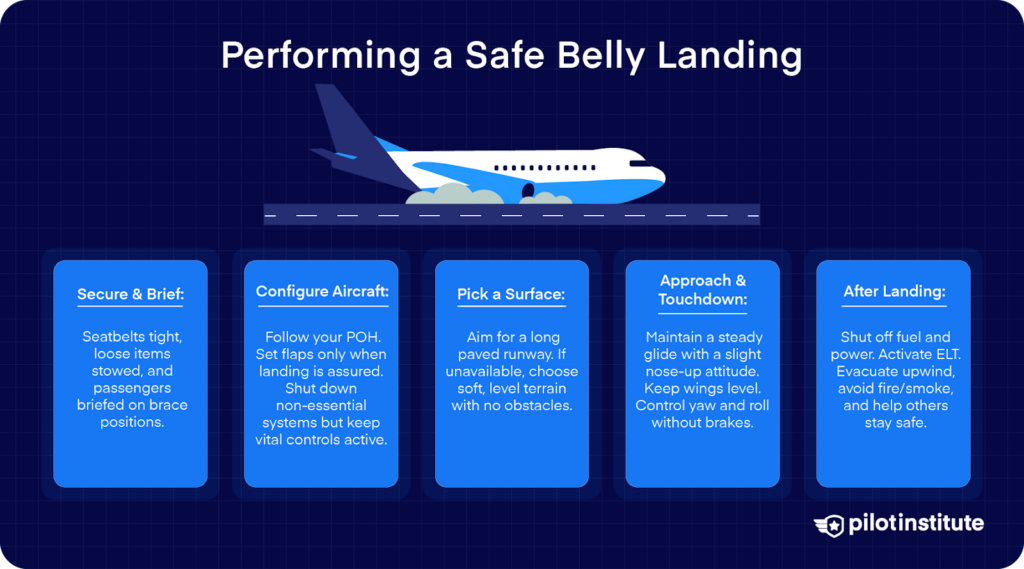
You’re mentally prepared, you’ve come up with a plan, and soon, you’ll have to make a belly landing. But while a rough touchdown feels inescapable, remember that you have every power to land your aircraft safely.
Secure & Brief
Start by securing the cabin. Seatbelts tight. Loose items stowed. Then, brief your passengers clearly and calmly. Walk them through the brace position and let them know what to expect.
Configure Aircraft
Set up the aircraft according to your POH. Use flaps only when landing is assured; they help, but too early and you’ll lose glide range.
Shut down non-essential systems to reduce fire risk, but keep vital controls powered. Leave the battery master on until you no longer need it. Shut down the engine just before touchdown to let it cool.
Pick a Surface
Your best option is a long, paved runway with emergency services. If that’s out of reach, go for open, soft terrain with no obstacles. Stay flexible; adjust as you get closer, and don’t stick to a bad choice if a better one appears.
Approach & Touchdown
Keep your approach steady. Aim for a slight nose-up attitude so the rear fuselage touches first; it spreads out the impact and protects the engine and propeller.
Keep the wings level and use rudder and ailerons to stay aligned. You won’t have brakes, so prepare for a long slide.
After Landing
Once stopped, shut off fuel and power. Activate the ELT if it hasn’t triggered. If radios are still working, contact emergency services or relay through ATC.
Evacuate quickly but safely. Use the nearest clear exit (a door, hatch, or window) and avoid smoke, fire, or fuel. Move upwind and guide others to safety. Stay calm, stay alert, and take charge if you can.
Belly Landing Recovery and Aftermath
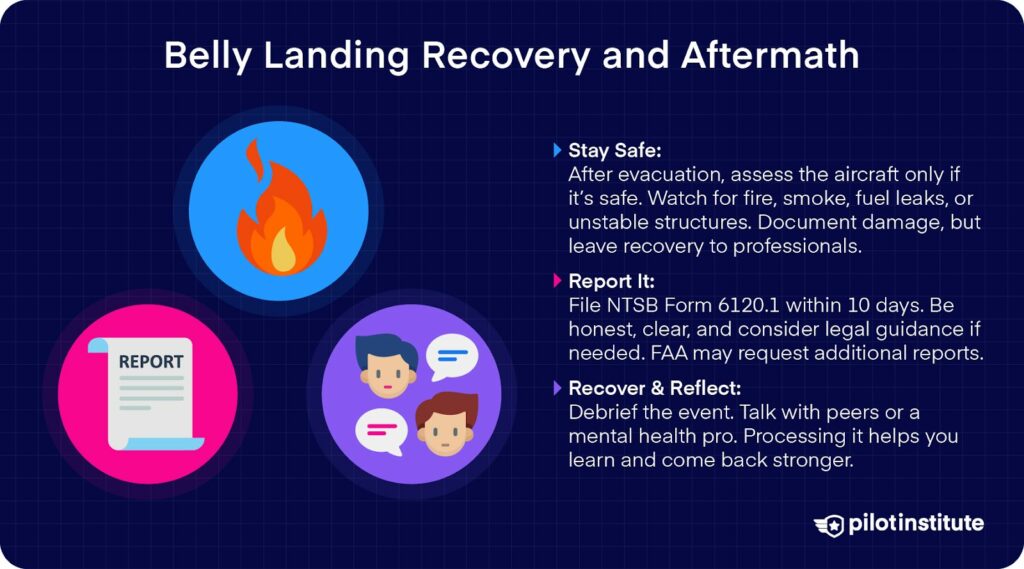
You made it! But unfortunately, the work isn’t over. Here’s what comes next:
Aircraft Assessment
After evacuating, don’t approach the aircraft until you’re sure it’s safe. The friction from a belly landing could cause something to catch fire. Make sure that there is no smoke, fire, or structural hazards.
Once clear, document visible damage with photos or notes from a safe distance. The information you gather will be helpful when you write down your statement.
Allow airport authorities to execute their emergency plans and procedures. Leave recovery to the professionals.
Regulatory Reporting
You’ll need to submit NTSB Form 6120.1 within 10 days. You’ll need to talk about the facts, conditions, and circumstances of the flight as they appear to you. Be honest and thorough in your statement about what happened. The FAA may also request a report, so consider seeking legal advice before submitting anything.
All this might sound intimidating, but honesty and discretion will serve you well.
Pilot Health and Recovery
Even after surviving an emergency landing, stress can linger. Talk it out with peers or professionals. Processing the event helps build resilience and makes you a better pilot.
Remember, taking care of yourself is also part of the job.
Case Studies of Belly Landings

It’s easier to be aware of how a belly landing happens when you read about previous cases. What does history tell us about belly landings, and how could we avoid making the same mistakes?
Let’s look at some case studies to better understand this phenomenon.
Case Study 1: Pilot Error Leading to Belly Landing
In September of 2022, a Piper PA-60 pilot was following a routine pattern training session in Richmond, Kentucky.
The weather was calm, and visibility was good. After six successful touch-and-go landings, the low-fuel light came on during the seventh approach. While also monitoring nearby traffic, the pilot became distracted and forgot to lower the landing gear.
The aircraft landed gear-up, skidding to a stop with significant damage but no injuries. The cause: distraction, cognitive overload, and failure to follow the checklist.
Even in routine flights, skipping steps under pressure can lead to serious mistakes. Checklist discipline matters every time.
Case Study 2: Mechanical Failure Resulting in Gear-Up Landing
Here’s another story, this time, about a mechanical failure.
It was late on October 4, 2023, when FedEx Flight 1376, a Boeing 757-236, departed Chattanooga for Memphis.
Shortly after departure, the crew received a flap disagreement warning followed by a left hydraulic system failure. Despite following emergency procedures, they couldn’t lower the landing gear in the down position using either the normal or alternate methods.
After a low pass confirmed the gear was still up, the crew declared an emergency and executed a successful belly landing back in Chattanooga.
The aircraft slid off the runway and struck antennas, but all three crew members evacuated safely with no injuries. The cause was traced to a hydraulic leak and wiring fault.
This incident showed the importance of training, clear communication, and checklist discipline in managing gear-up landings.
Conclusion
Belly landings demand more than luck; they demand preparation.
Know the causes, follow your checklists, and train like it matters, because it does.
Review your emergency procedures often. Stay sharp. Stay ready. Keep flying smart.



